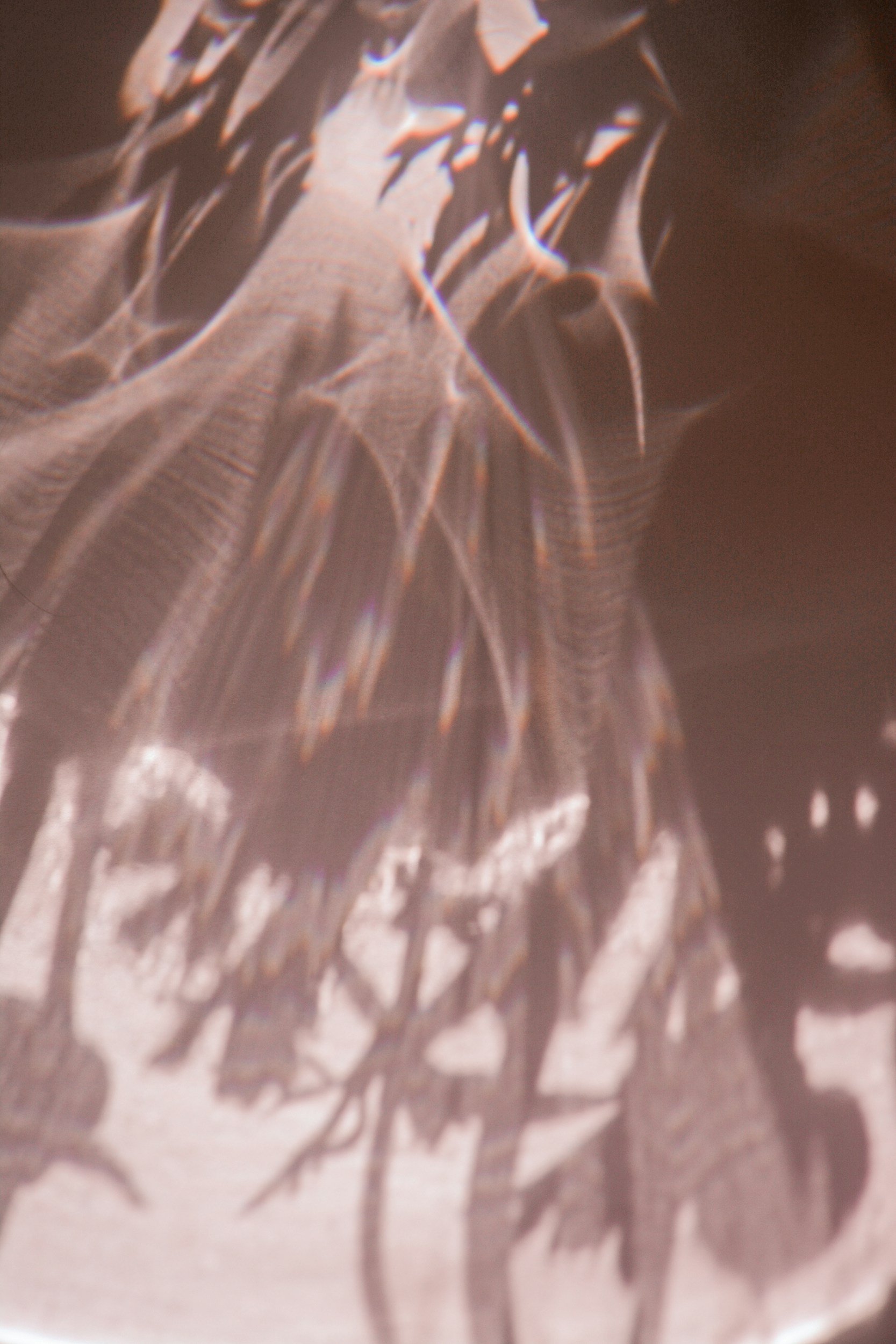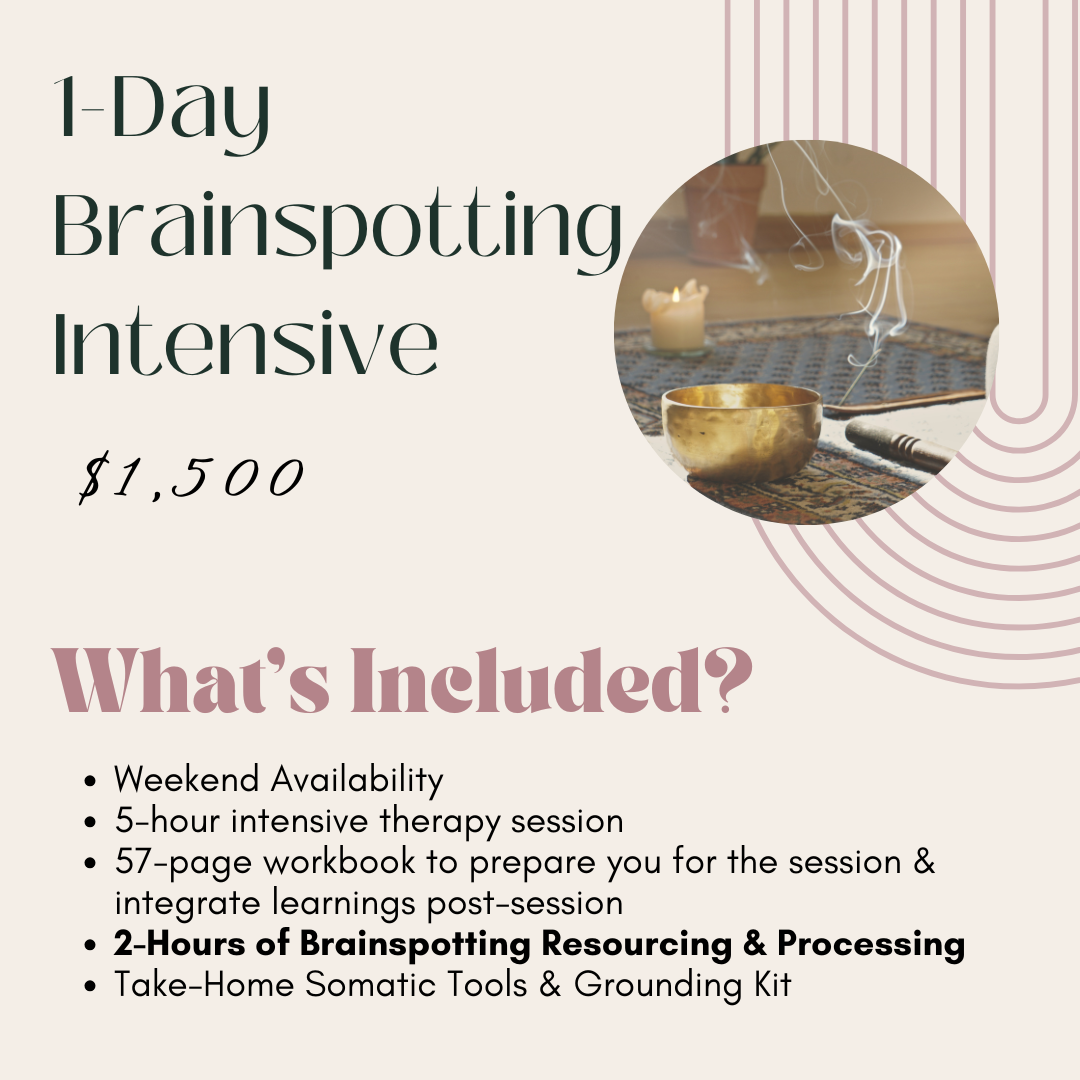
Trauma Therapy Intensives with Brainspotting in Racine, WI
Gently process and release what's been holding you back with Brainspotting — a private, one-time intensive designed for deep emotional healing.
Experience the depth of months of therapy - in just one powerful session.
What if your healing didn’t have to wait?
You’ve spent months—maybe even years—in therapy trying to make sense of it all. You’ve gained insight, learned coping tools, and yet… something still feels unfinished. The same patterns keep showing up: perfectionism that pushes you to your limits, relationships that leave you questioning your worth, grief that resurfaces when you least expect it. You wonder if lasting healing truly exists, or if you’ll always feel this way.
Your nervous system feels overworked, your body tense from holding what your mind can’t quite release. You may not have words for it anymore—you just know you’re tired of carrying so much alone. A Trauma Therapy Intensive with Brainspotting offers a focused, immersive space to go deeper than talk alone—to process what’s been stuck in your body, reconnect with your core self, and create lasting shifts from the inside out.
How Can Brainspotting Therapy in Racine, WI Help You?
Deepen self-awareness, self-trust, and compassion
Support emotional regulation and nervous system balance
Unlock creativity, insight, and personal growth
Reconnect with your inner sense of clarity and direction
Heal from trauma, PTSD, and distressing life experiences
Navigate grief, loss, and life transitions
Reduce anxiety, overwhelm, and chronic stress
Gently release stored emotional tension and patterns
What is Brainspotting Therapy?
There’s a saying in Brainspotting: “Where you look affects how you feel.”
Our eyes are deeply connected to our nervous system. That means the way we hold memories, stress, and even trauma in our bodies can be accessed through where we focus our gaze.
A simple way I explain this to my clients in session, is with the simple question - What did you have for dinner two nights ago? - Go ahead, try it.
Notice what you just did with your eyes? Your eyes are searching those deep areas of your brain to find the information that it needs. You’ll notice your eyes will often naturally do this as we talk about difficult emotions or memories as well. Through your gaze, we locate a spot that connects with the deeper part of your brain — a window into what your body and mind have been carrying — so that release and healing can naturally begin.
This is your body’s natural way of healing - we’re just opening the door to allow that healing to happen a bit faster.
Whether you're working through trauma, seeking emotional clarity, or looking to deepen personal growth. By using eye positions and tuning into your body's felt sense, Brainspotting supports healing, integration, and greater connection to your inner self. You can read more about Brainspotting here: https://brainspotting.com/
Trauma Therapy Intensives with Brainspotting in Racine, WI
What to Expect in a Brainspotting Intensive
Your Brainspotting Deep Healing Session is designed to offer space for focused transformation in a safe and supportive environment. The session is thoughtfully divided into five parts to help you feel grounded, guided, and empowered throughout the process:
Comprehensive Intake Session (Day 1 Only)
We’ll begin with a dedicated intake where I learn more about your history, attachment patterns, trauma, current triggers, and coping strategies to shape a plan that feels safe and personalized.Intention Setting & Somatic Awareness
Together we’ll clarify the focus of your intensive and bring awareness to how your body carries stress or emotion, helping you feel grounded and prepared for the work ahead.
Brainspotting Processing
You’ll be guided through a focused Brainspotting process that aligns with your goals, pacing, and nervous system capacity. This part of the session is quiet, spacious, and attuned to your internal experience. You are welcome to process verbally or silently — there's no right or wrong way.
Grounding & Regulation
After processing, we’ll ease into grounding. This may include aromatherapy, breathwork, meditation, or somatic exercises to help your body integrate the work. These tools are tailored to what feels most regulating and restorative for you.
Reflection & Integration
We’ll close with time to reflect on what surfaced during your session and explore how to carry insights forward. This may include discussion, journaling prompts, expressive arts or suggestions for ongoing integration. If helpful, I can also provide referrals or resources to support your continued healing.
Brainspotting FAQ’s
-
Absolutely! I incorporate Brainspotting into my practice with all my weekly therapy clients. There is no extra fee for this, it is included in your normal hourly session fee.
-
Yes. Brainspotting can be just as effective through telehealth as it is in person. Many clients actually prefer the comfort of being in their own space while processing. I’ll guide you step-by-step, making sure you feel supported and connected throughout the session. All you need is a private, quiet space, a reliable internet connection, and a device with a camera so I can see your eye position.
-
Before scheduling an intensive, I offer a free 15-minute phone consultation where we’ll talk about your goals and explore which option is the best fit for you.
A 1-Day Intensive is often a good choice if you’d like to focus on healing around a single issue, or if you’ve worked with somatic therapy modalities such as EMDR or Brainspotting before and want to deepen that work.
A 3-Day Intensive is typically recommended if you’re navigating more complex trauma, ongoing patterns of anxiety or depression, relational struggles, grief and loss, or if you’d like to focus on more than one area of healing. This format allows more time and space for your nervous system to process, integrate, and reset between sessions.
-
Yes. Brainspotting is a relatively new therapy approach (developed in 2003), and research is growing quickly. Current studies show it to be effective for trauma, anxiety, depression, and performance blocks. While it doesn’t yet have as large a body of research as more established therapies like CBT or EMDR, Brainspotting is considered an evidence-based, neuroscience-informed method. Many clients report powerful results, and it is increasingly being used by trauma specialists worldwide.
-
While Brainspotting was originally developed as a way to heal trauma, it can support many areas of life. Clients often use it to work through anxiety, grief, loss, burnout, performance blocks, self-worth struggles, and patterns that feel hard to shift through talk therapy alone. Because Brainspotting works with both the brain and body, it helps uncover and release what may be stuck beneath the surface—whether that’s connected to a past trauma or to everyday stressors.
-
Many clients find that intensives create deeper shifts in a shorter period of time compared to traditional weekly therapy. Instead of spreading the work out over months, you have the opportunity to immerse yourself in focused healing and leave with tools, insights, and relief that you can carry forward.
An intensive is an investment in yourself—your healing, your relationships, and your future. While the cost may feel significant up front, many people find that the concentrated format saves them both time and money in the long run. During our free 15-minute consultation, we’ll discuss your goals to make sure this approach is the right fit for you.
Common Myths and Misconceptions About Brainspotting Therapy
Myth 1: “I’ll have to relive my trauma in detail.”
Fact: Brainspotting does not require you to retell or re-experience painful memories. The focus is on your body’s natural processing, not on describing events. You remain in control of how much or how little you share.
Myth 2: “Brainspotting is a form of hypnosis.”
Fact: Brainspotting is not hypnosis. You are fully awake and aware throughout the session. Instead of putting you into a trance, Brainspotting gently helps your brain and body access where trauma or stress is stored so it can release.
Myth 3: “If I don’t feel anything during the session, it didn’t work.”
Fact: Healing looks different for everyone. Some clients notice big emotional releases in session, while others feel more subtle shifts that integrate over days or weeks. Both experiences are valid.
Myth 4: “Brainspotting is only for people with trauma.”
Fact: While Brainspotting is highly effective for trauma, it can also support people with anxiety, grief, life transitions, relationship struggles, or even creative or performance blocks. It’s a flexible tool for growth and healing.
Myth 5: “One session will fix everything.”
Fact: A single intensive session can create profound change, but healing is often a process. Some clients choose to do multiple sessions, integrate Brainspotting into ongoing therapy, or use it alongside other supportive practices.
What Does a Brainspotting Therapy Session Look Like?
Gentle. Collaborative. Guided by your nervous system.
From the start, you set the pace. You choose what feels most important to explore — a memory, a pattern, or simply a sense of being “stuck.” Together, we find a brainspot — a point in your visual field that connects to the deeper experience your body is holding.
✨ Step 1: Finding the Focus
We begin with conversation and curiosity. You share what feels ready to work on — no pressure, no rush.
👁️ Step 2: Locating the Brainspot
Using natural eye positions and your body’s cues, we find where your nervous system responds. This spot becomes a doorway into the deeper layers of healing.
🌬️ Step 3: Allowing What Unfolds
You don’t have to analyze or make sense of it. You simply notice sensations, emotions, or images as they arise while I help you stay grounded and supported.
🌙 Step 4: Integration
Every session unfolds differently. Some clients feel lighter or more at ease right away, while others notice gradual shifts in the days that follow—like improved sleep, a steadier mood, or more clarity in their relationships. These changes often continue as your brain and body process what was released during the session.
Clients often describe feeling lighter ☁️, calmer 🌿, and more connected 💫 to themselves. Every session honors your pace, your body’s wisdom, and your natural capacity to heal.
Trauma isn’t just something that happened in the past — it’s what your body continues to carry in the present. For those living with PTSD or trauma-related symptoms, this can look like hypervigilance, intrusive memories, emotional numbness, or sudden triggers that feel out of your control. Even years later, your nervous system may still be “stuck” in fight, flight, or freeze mode.
Brainspotting goes beyond traditional talk therapy by working directly with the brain and body. By identifying a “brainspot” — a point in your visual field linked to an unprocessed experience — your nervous system can finally access and release what has been held beneath the surface. This process isn’t about reliving trauma, but about allowing your body to safely complete what it once couldn’t.
With Brainspotting, you can:
Calm your nervous system. Move out of chronic fight, flight, or freeze responses.
Reduce the intensity of triggers. Gain a sense of stability and control over emotional reactions.
Process trauma safely. Access deeper healing without needing to retell or re-experience painful memories.
Feel more present and connected. As your body releases tension, daily life, relationships, and work begin to feel more manageable.
Reclaim inner balance. Experience a greater sense of calm, safety, and self-trust.
Brainspotting for Trauma and PTSD
Brainspotting Therapy for Grief & Loss
Grief can touch every part of your life — your sleep, your energy, your sense of purpose. Whether you’re mourning the death of a loved one, the end of a relationship, or another painful loss, the ache can feel endless. You may have talked through your story many times, but still feel something heavy lingering beneath the surface. That’s because grief doesn’t just live in the mind — it lives in the body and nervous system.
Brainspotting helps you access and gently release those deeper layers of emotion, offering a safe space to process what words alone can’t reach.
With Brainspotting, you can:
Process grief without pressure. There’s no need to “move on” before you’re ready.
Release what’s been stored in the body. Eye positions connected to the midbrain help calm the nervous system and soften the weight of loss.
Feel and integrate emotions safely. Sadness, anger, guilt, or numbness are welcomed—not forced away.
Reclaim connection and meaning. Many clients describe feeling more open to moments of love, gratitude, and peace.
Honor your own pace. Healing unfolds naturally, respecting where you are in your journey.
Brainspotting for Creativity & Performance Blocks
Even the most motivated and passionate people can hit a wall — moments where inspiration fades, focus disappears, or fear of failure takes over. These creative or performance blocks often stem from the same parts of the brain that store unresolved stress, self-doubt, or perfectionism. When your nervous system perceives risk, it can shut down the very flow that fuels creativity and confidence.
Brainspotting helps you access and release the internal barriers that keep you feeling stuck. By working with your body’s natural responses, you can quiet the inner critic, ease performance anxiety, and reconnect with your authentic sense of flow — whether you’re an artist, athlete, entrepreneur, or anyone striving to create from a deeper place.
With Brainspotting, you can:
Ease performance anxiety. Calm the body’s stress response and approach challenges with more confidence and clarity.
Quiet the inner critic. Reduce self-doubt and the pressure to be perfect, allowing creativity to feel more natural.
Reignite inspiration. Reconnect with curiosity, play, and the joy of creating without fear of judgment.
Improve focus and flow. Strengthen your ability to stay present and grounded during performance or creative work.
Access deeper expression. Feel more connected to your intuition and emotional truth in both work and art.
Brainspotting for Self-Worth and Identity
Many people spend years feeling “not enough.” These beliefs often begin early — shaped by the messages we received, the relationships that left us doubting ourselves, or the habit of always putting others first. Over time, those experiences can blur our sense of who we are, leading to people-pleasing, self-criticism, or a quiet disconnection from our authentic self.
Brainspotting offers a way to move beneath the surface of these patterns. By working with both the brain and body, it helps uncover and release the deeper emotional imprints that keep low self-worth in place. As old beliefs begin to soften, clarity and confidence can naturally take root — helping you reconnect with your voice, values, and inner strength.
With Brainspotting, you can:
Release old stories. Gently process the experiences that shaped self-doubt and replace them with a sense of self-trust.
Reclaim your authenticity. Feel more connected to your true self rather than who you’ve been told to be.
Set boundaries with confidence. Notice a growing ease in saying “no” without guilt or fear.
Cultivate self-compassion. Experience a deeper kindness toward yourself that feels genuine, not forced.
Step into possibility. As your nervous system settles, self-worth begins to feel like something lived — not earned.








